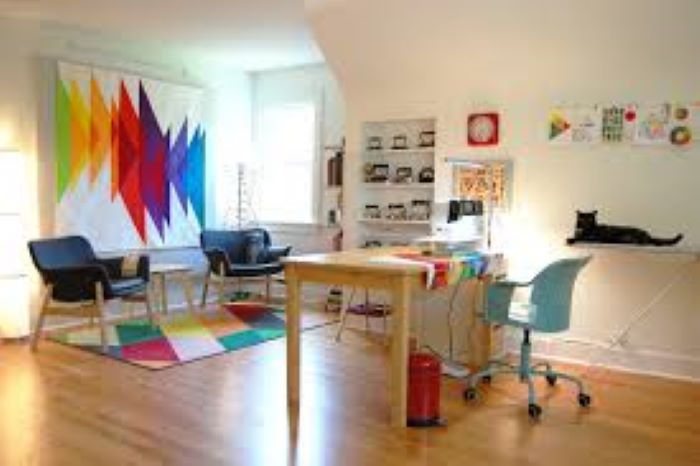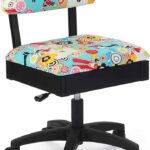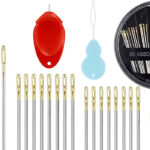You can fix the problems related to sewing room lighting by following these tips. Use ambient lighting as an even source of lighting. Natural light is the best source of ambient light for your workplace. To get maximum natural light keep your windows clean. Use wall windows or roof glass panels.
Use light color paint for walls and ceilings. You must install LED bulbs as they don’t emit heat and the true colors of the fabric are visible. The window curtains must be of thin fabric so that maximum light could stream through the windows.
If you are working on an embroidery piece then task lights with magnifiers are strongly recommended. These magnifiers will help to see the designs clearly. Remove all extra wall art or framed designs from the wall. Light color carpet or rug could be used for the floor.
If you sew and experience eye fatigue or poor lighting conditions in your sewing room, consider using a daylight illuminator to help improve your productivity. If you want to avoid all these frustrations when sewing, you should install proper sewing room lighting. This will help you see what you are doing and make sewing easier.
What is the importance of sewing room lighting?
Eyestrain and posture: While sewing posture and lighting matter a lot. It helps you tremendously in sewing. With better light, you can sew longer and become less tired. It is tiring for your whole body if your eyes are working too hard in dim light.
In dark or low light you strain to see the fabric and thread. This straining causes poor posture of your body resulting in fatigue and tiredness. The sewing room lighting should be bright and cheery to help the sewers stay focused on their work.
Tint in light: In our homes, our overhead lights have some sort of tint to them. It makes the fabric look a little more yellow or blue. This is not the true color. Natural light through the windows is best for the sewing room lighting. Sometimes you do need to go outside in the sunlight to see the original color of the fabric or thread.
Matching colors: Light is very important when matching colors of fabric and thread. In the USA we have gray skies all fall and winter so sewing room lighting is important. We get very little natural light during these dark winter months.
Sewing room lighting is very important for both the visibility of the fabric and the quality of the sewing. The right kind of lighting can help you see the fabric clearly, and can also improve the quality of your sewing by making it easier to see the stitches and the fabric surface.
What are the different bulbs available in the market?
What types of illuminators are available in the market? There are many types of illuminators available in the market, but the most common ones are incandescent, fluorescent, and LED bulbs.
Incandescent light bulbs: What are incandescent light bulbs? Incandescent bulbs are a type of light bulb that uses heat to lighten the room. They are usually made of a thin metal filament that is heated until it glows. These bulbs are less efficient, produce heat than other light bulbs, and typically last between 1,000 and 2,000 hours. These lamps have tints in their light. The use of these bulbs has almost ended. Never use incandescent bulbs for sewing room lighting.
Fluorescent light bulbs: What are fluorescent bulbs? A fluorescent lamp emits light from high-energy collisions in hot gas. The heat from these collisions excites the atoms in the gas, and they emit light. A fluorescent bulb is a type of bulb that uses fluorescent tubes to generate light. The fluorescent bulb uses a small electric current to light up a small fluorescent tube. These bulbs produce less heat than incandescent light bulbs.
LED bulbs: What is an LED bulb? LED bulb uses light-emitting diodes (LEDs) to brighten the space. LEDs are much more efficient and long-lasting than incandescent bulbs, and they are becoming increasingly popular due to their low energy consumption. Less heat is produced by LED bulbs because they use less energy. LED bulbs are highly recommended for sewing room lighting.
What type of light do we need in my sewing space?
In winter it is hard to get natural light. Daylight bulbs are the best source of natural light. LED bulbs are designed to last for about 15 thousand to 50 thousand hours. If calculated in years it becomes 15 years. They last for a long time and provide natural light so you truly see your colors. These LED lights never get hot. No worries that these will warm your room. Almost all the lights come with different light settings that you can use according to the situation and are best for sewing room lighting.
Our sewing machine needs to be properly lit. With high-quality lights, we can use our sewing machine to its full advantage, see the true colors of fabrics, and enjoy a more pleasant quilting experience and the creation of beautiful quilts.
- Slimline series (table version and floor version) They are super flexible lights with magnifiers (You can have beautiful magnification)
- Cordless lights with and without magnifiers
- Sewing machine lamp (Doesn’t have enough light)
- Task light
- Wafer light
Sewing room lighting should be bright, but not too bright. It should be able to illuminate the fabric without making it too uncomfortable to work in. It should also be able to reflect light off the fabric so that you can see what you’re doing.
These lights typically cost more initially, but they will outlast and outperform cheaper alternatives. My personal favorite lights are of daylight company. Their lights are best alternated to daylight. We have gathered some tips on your sewing room lighting.
10 sewing room lighting tips:
- Ambient lighting
- Wall colors or wall paint color
- Floor color (Use lighter color carpets)
- Install magnifiers or use LED lights with magnifiers
- Ceiling color
- Minimalism
- Keep your windows clean
- Curtains
- Mirrors
- Change your bulbs
Ambient lighting (Even light throughout the room):
Ambient lighting is called general lighting because it provides an area with overall illumination. When ambient light radiates at the right intensity, it’s a source of comfort that enables one to work comfortably for longer.
Ambient lighting is free from distracting glare and bright enough to prevent fatigue and eye strain. Never use color lights to illuminate your working area.
This is a basic form of lighting that replaces sunlight, ambient lighting is the key to sewing room lighting. Ambient lighting can be achieved with chandeliers, ceiling or walls mounted fixtures and task lights.
Wall paint furniture color
The colors of the walls must not be ignored. You should have knowledge that lighter color reflects more light and darker colors absorb more light. White color reflects maximum light. For your sewing room lighting, you must color your walls with white paint. If you don’t like white, you must go with lighter colors.
Many people are tempted to use dark colors to enhance the look of their rooms. Putting dark colors like violet, green, blue, etc absorb maximum radiations. To prevent this issue you can use stickers, these stickers will increase the beauty of your crafts room without absorbing light.
Never use dark-colored furniture as it absorbs more radiation. Furniture of black color absorbs maximum radiation not letting the radiation reflect.
Flooring (Use lighter color carpets)
There are tons of choices for flooring. It is highly recommended to use light wood or lighter-colored carpet. If changing flooring or carpet is not in your immediate budget consider adding a large white or cream-colored rug.
If your floor is of dark color and you want to brighten the room then you need to change it to a lighter color. Use light-colored tiles or lightening tiles for sewing room lighting.
Install magnifiers or use task lights with magnifiers
These magnifiers are used with task lights. Magnifiers are specially designed for better visibility. Such gadget helps to study internal design. The magnifiers are used in conjunction with task lights. A single task light could have more than one magnifier. The magnifiers help to see better in low-light environments. They are also very helpful in embroidery work.
Ceiling color
The ceiling paint has a huge impact on the sewing room lighting. We often overlook the ceiling paint which has proved to be an essential indicator in interior decoration. If you will paint the ceiling with dark color then it will give you a small look at the room.
On the other hand, you can use a lighter color to give a bigger look to your sewing room. It all depends upon the colors to make it look bigger or smaller. This technique is very useful in small rooms.
Minimalism
Remove all extra and dark color wall art as they absorb radiations. This causes darkness in the sewing studio. No need to overelaborate walls. Keep your sewing studio neat and simple. In sewing rooms mostly two kinds of decoration are used, wall decoration pieces and unfinished projects. Remove all wall decor pieces, framed designs, or any unfinished sewing pieces from the walls.
Keep your windows clean
One way to increase sewing room lighting is to keep the windows clean. This will allow more light to enter the room and help to improve sewing skills.
To brighten your studio you can replace wooden windows and doors with glass. Natural light easily passes through these windows. If you cannot place wall windows you can place roof glass panels or windows. They will let the natural light enter the room. Try to use light-colored panels.
Curtains
If your room is dark then you have to make arrangements for sunlight to stream in through your windows. It is almost impossible when curtains are of dark-colored or of heavy fabrics. These curtains are draining all the sunlight.
Use diaphanous or sheer curtains, light in texture and color. These curtains will allow sunlight to stream through your windows. This will help you to brighten up your studio and make it more cheerful. To achieve a diaphanous curtain look, you will need to purchase a sheer curtain or one with a very thin fabric. You can also use a sheer curtain liner to achieve the desired look.
Mirrors:
It’s age-old advice to use mirrors to enhance visual space and brightness. Place a mirror near the window or source of light for sewing room lighting. Placing a mirror near a light source reflects light back into the space. Placing mirrors near the lamps also has the same impact by amplifying the light.
Change your bulbs
Changing your light bulbs can make an instant and amazing difference. There is a remarkable difference between soft white bulbs and daylight bulbs. Daylight bulbs emit a white light that will brighten your crafts room. Avoid fluorescent lighting, which is harsh and makes it difficult to see what you’re doing.
When choosing sewing room lighting, keep in mind that the lighting should be soft and indirect to allow for a comfortable working environment. Additionally, consider installing dimmers to adjust the light level to the individual’s needs.
One more good thing about daylight bulbs is that they don’t emit heat. They will not heat up your sewing space. They will keep your sewing space bright without the production of heat. If you are grown old then your aging eyes need good lighting. My favorite company is the daylight company that manufactures the best daylight bulbs for sewing room lighting.
Conclusion
All the tips given above are practically based. If you want to illuminate your sewing space then you must follow the following ten sewing room lighting ideas. Don’t sew in dim light or dark rooms.
Replace all old bulbs with new LED bulbs. You must use daylight as the main source of light. Keep your windows clean and use the diaphanous curtain. Remove light-blocking curtains. LED bulbs are the best for sewing room lighting.
You must know the concept that dark objects absorb maximum light radiations. Always use light-colored furniture and wall art. Remove items from the walls that are absorbing light radiations.
If you’re painting a room white, it’s best to use a light color. These colors will reflect more light back into the room, creating a more comfortable and inviting atmosphere.
You will need this when sewing and especially if you are into quilting. Quilting is a craft that requires more detailed work than most crafts. Since quilting has more intricate patterns, it is important to increase your lighting. You can also use task light.
Even if you install quality LED light bulbs in an overhead light or a household lamp, you will still need a task light to fight shadows that will interfere with your work.
Sewing room lighting should be bright, but not too bright. It should also be adjustable to fit the needs of the individual sewers.
The best way of sewing room lighting is to use LED bulbs. You can also use sunlight and an overhead light. You can buy daylight bulbs from the daylight company.A light fixture with a few simple, classic lamps to provide a soft and relaxing ambiance.
A bright, cheerful light to help you see your work clearly. A light that casts a warm glow, perfect for a cozy sewing room.









